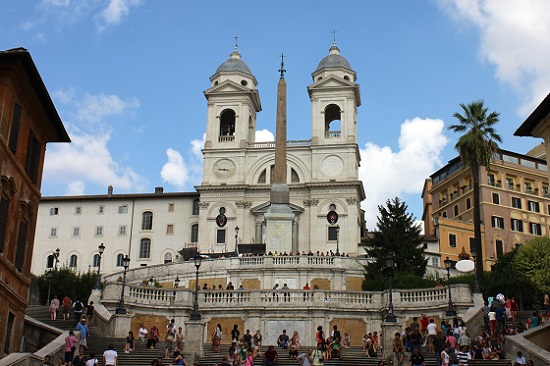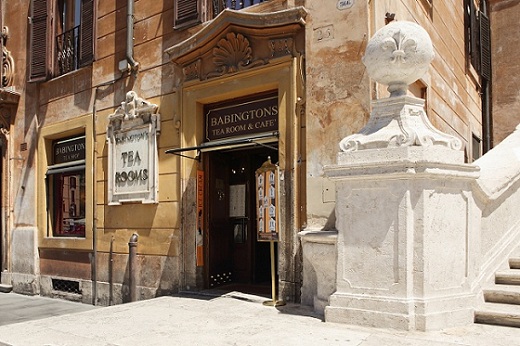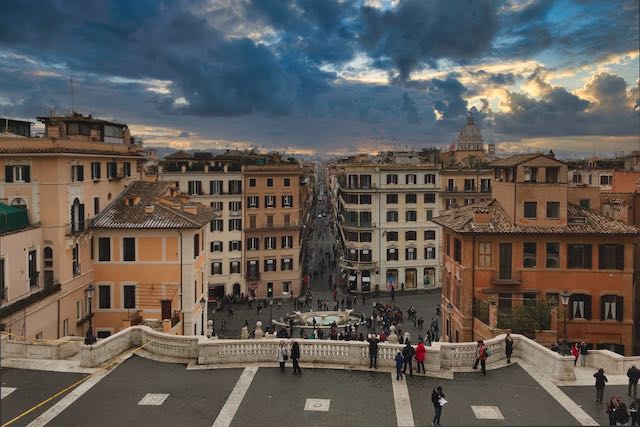- Sign up & get a FREE ebook Subscribe NOW!
- Romewise Home Page
- Spanish Steps Rome Italy
- What Are the Spanish Steps
What are the Spanish Steps? A fascinating history!
What are the Spanish Steps?
Why are they called that?
Who built them and why?
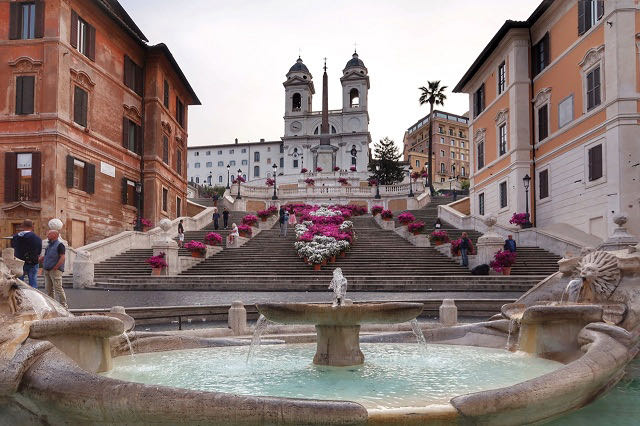 The most famous staircase in Rome, the Spanish Steps, is the largest monumental staircase in Europe.
The most famous staircase in Rome, the Spanish Steps, is the largest monumental staircase in Europe.Find out the answers to these questions and more!
What are the Spanish Steps? - A short history
Yes, the famous Spanish Steps in Rome are worth visiting.
They are usually on most "top-ten" lists of things to see in Rome.
But why should you see them?
Why are they called the Spanish Steps?
Who built them and why?
What is the meaning of the fountain at the bottom?
The most famous steps in Rome Italy
To answer the question "What are the Spanish steps?", we have to talk about the different parts that make up this monumental stairway.
As with the history of just about everything in Rome, it goes through a period of a few hundred years.
On this page, you'll find some quick and fascinating facts about the Spanish Steps in Rome, including a brief history of:
- The church at the top of the Spanish Steps
- The obelisk at the top of the Spanish Steps
- The Spanish Square at the bottom of the Spanish Steps
- The monumental staircase itself
- The boat fountain at the bottom of the staircase
- The Keats-Shelley House and other historic landmarks next to the Spanish Steps
We'll start our history literally from the top and work our way down.
TRINITÀ DEI MONTI CHURCH
The church at the top of the Spanish Steps is called Santissima Trinità dei Monti or just Trinità dei Monti, or actually La Trinité-des-Monts, since it is a French church.
The church has been there since the 1500's.
Originally, there was just a sloped dirt hill in front of it, leading down to the square below.
It's worth a visit inside the church to see two paintings by Daniele da Volterra.
His "Deposition" is probably his most famous work.
It's probable that his good friend Michelangelo provided the sketch for it.
I also love his other work in this church, the "Assumption of the Virgin Mary."
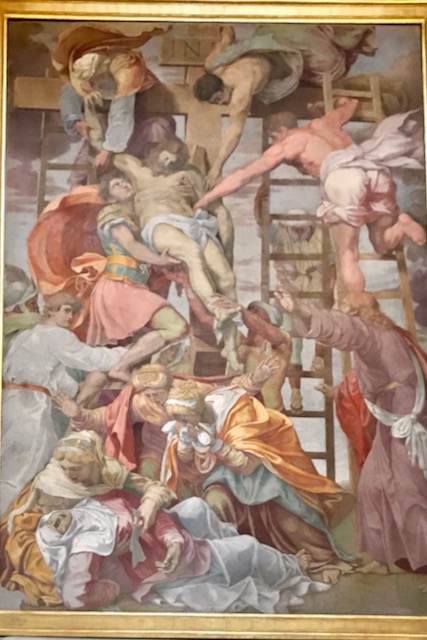 Daniele da Volterra, Descent from the Cross, circa 1545
Daniele da Volterra, Descent from the Cross, circa 1545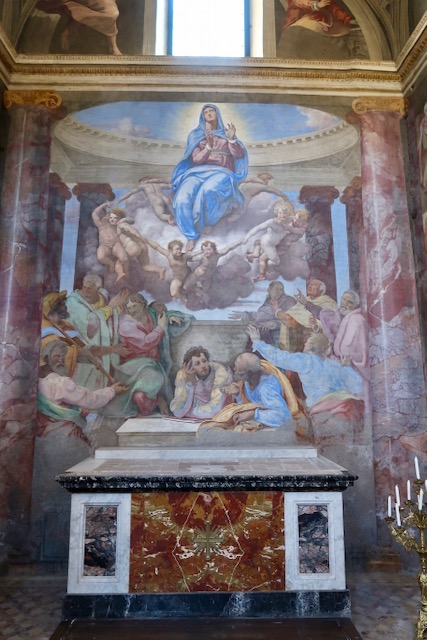 Daniele da Volterra, Assumption of the Virgin Mary, circa 1552
Daniele da Volterra, Assumption of the Virgin Mary, circa 1552Opening hours:
Monday, Tuesday, Thursday, Friday, Saturday: 10 am – 8 pm
Wednesday : 12 noon – 8 pm
Sunday: 9 am - 8pm
The obelisk at the top of the Spanish Steps
Why is there an obelisk at the top of the Spanish Steps?
The obelisk in front of the church looks Egyptian but in fact it's a Roman copy.
The original is twice the size and you can find it in Piazza del Popolo just down the Pincian hill from the church.
The obelisk is called the Obelisco Sallustiano, because it was made in the early years of the Roman Empire for the Gardens of Sallust.
So this obelisk is a mere 2,000 years old as opposed to the original Egyptian obelisk in Piazza del Popolo which is around 4,000 years old.
The obelisk was moved here in 1789.
You can get a good look at it from the staircase of the church.
Jump start your trip to Rome with a free ebook 😀
Sign-up to our free newsletter and receive our Quick Start Guide to Rome ebook which share's everything you need to know to plan the perfect trip to the Eternal City 🙌
PIAZZA DI SPAGNA - THE SPANISH SQUARE
Why are the Spanish Steps called the Spanish Steps?
The answer may surprise you, considering that the Spanish Steps were a French project!
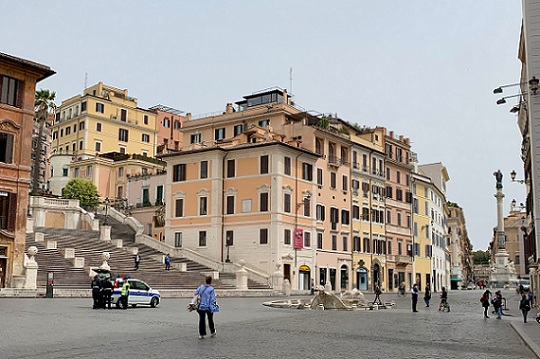 What are the Spanish Steps? It starts with the Piazza di Spagna, or the Plaza of Spain.
What are the Spanish Steps? It starts with the Piazza di Spagna, or the Plaza of Spain.The "plaza" at the bottom of the Spanish Steps is sometimes called "The Spanish Square" in English, although it is definitely not square shaped.
It's kind of like a sharp-edged hourglass, with the smallest point being the bottom of the steps, and the larger ends fanning out left and right from there.
In the 18th century, nearby Porta del Popolo (where Piazza del Popolo is) was the main entrance to Rome.
Inns popped up in the area to accommodate visitors to the city.
The overall area became known as the Strangers' Quarter.
 An etching by Giuseppe Vasi from 1752 shows the square known even then as Piazza di Spagna thanks to the Spanish Embassy to the Holy See which was then as it is today on the right-hand side of this image.
An etching by Giuseppe Vasi from 1752 shows the square known even then as Piazza di Spagna thanks to the Spanish Embassy to the Holy See which was then as it is today on the right-hand side of this image.Anyway, the plaza is called Piazza di Spagna in Italian because of the Spanish Embassy to the Holy See, which has been based there since 1647.
For more about this history, check out one of my favorite Roman-history websites, Romeartlover.
The perfect 3-day itinerary in Rome
Trying to figure out how to organize your visit to Rome? I've got the perfect 3-day itinerary for first-time visitors (or those who have not been here in a while.) It works for a 2.5 day visit as well.
In my 3-day itinerary, you'll see all the major must-see Rome attractions like the Vatican, Colosseum, Trevi Fountain, Pantheon, Piazza Navona, Spanish Steps, and much more.
And if you have more time, or want suggestions for extra/other things to do, you'll find that there too.
Visit my page with the best 3-day itinerary in Rome for first-timers.
LA SCALINATA DI TRINITÀ DEI MONTI - THE SPANISH STEPS
In the mid 1600's, the king of France started negotiating with the pope about how to build a staircase that would link the French church at the top with the plaza below.
In between the two there was just a dirt-covered hill.
 The Spanish Steps were designed to connect the French church at the top of the hill with the Spanish Square below. Until then, it was just a dirt hill separating the two.
The Spanish Steps were designed to connect the French church at the top of the hill with the Spanish Square below. Until then, it was just a dirt hill separating the two.This discussion (and ensuing arguments) went on for about 100 years (with different kings and popes, of course) until finally, in 1717, Pope Innocent XIII held a contest and commissioned the design to Francesco de Sanctis and Alessandro Specchi.
The staircase, (scalinata in Italian), was built between 1723-1725.
It has 135 steps and is the widest staircase in Europe.
SKIP THE LINE AT THE COLOSSEUM
LA BARCACCIA - THE FOUNTAIN AT THE BASE OF THE SPANISH STEPS
The fountain at the bottom is called "La Barcaccia", which means "ugly boat."
As much as I love the name, I can't say I agree with it!
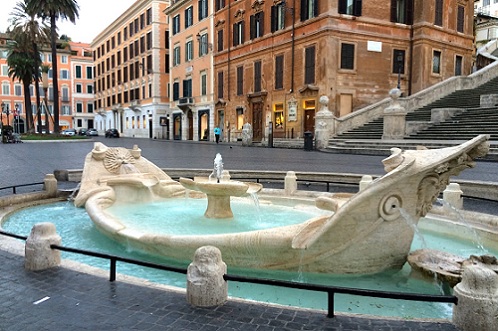 The Barcaccia fountain at the bottom of the steps was designed by Pietro Bernini with some help from his son Gian Lorenzo Bernini.
The Barcaccia fountain at the bottom of the steps was designed by Pietro Bernini with some help from his son Gian Lorenzo Bernini.The fountain was built by the father of one of Rome's most famous and prolific architects, Gian Lorenzo Bernini: Pietro Bernini.
It seems that Gian Lorenzo may also have helped in the design.
The barcaccia was built in 1627-29, and the reason it is attributed more to the father than to the son is that Pietro Bernini was in charge of the distribution of the water from the Acqua Vergine, one of Rome's ancient aqueducts that had only been recently restored.
Low water pressure from this aqueduct was likely the reason for the design of the boat.
Historic landmarks near the Spanish Steps
What are the Spanish Steps famous for besides the staircase and square?
The area was popular in the 1700s and 1800s as a stopover for visitors to the city on the Grand Tour.
A few vestiges of those days still remind us of what this neighborhood must have been like back then.
Keats and Shelley House
Romantic English Poet John Keats moved to Rome in hopes that the mild climate would cure him of his illness (tuberculosis).
 What are the Spanish Steps? They are also known as the place where English poet John Keats lived and died in the 1800s.
What are the Spanish Steps? They are also known as the place where English poet John Keats lived and died in the 1800s.Sadly, he had not counted on the damp winters we can get here.
Keats died in Rome in 1821 and is buried here in the Protestant cemetery, along with other luminaries such as Percy Bysshe Shelley.
The house Keats lived in is just to the right of the Spanish Steps at the bottom.
Today a museum, the Keats-Shelley House.
It's worth a visit to see how the poet lived, and to see something a bit unusual in Rome.
No matter what season you visit Rome, here are 4 essential things we recommend never leaving home without:
Babingtons Tea Rooms
In another example of the English influence over the area around the Spanish Steps, Babington's Tea Rooms is an iconic spot just to the left of the bottom of the staircase.
Opened in 1896, it harks back to a bygone era and is an absolutely delightful spot to enjoy tea, snacks, and my favorite, brunch!
Ready to plan your trip?
Book your train
Planning to travel between cities in Italy and other parts of Europe?
Use Trainline to see all the different options available across the different rail companies.
Find your hotel
Find your perfect place to stay in Rome.
Use Booking.com to choose between hotels, guesthouses, and self-catering apartments in neighborhoods throughout the Eternal City.
Buy your TurboPass
Purchase the convenient Turbopass and visit all of Rome's top attractions including the Colosseum, Pantheon, and Vatican.
With one handy pass, it's all included.
Caffè Greco
Rome's oldest café opened its doors in 1760.
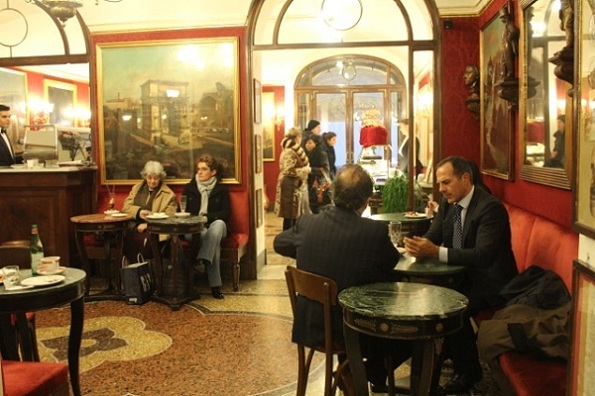 Enjoying a leisurely coffee, tea or hot chocolate at Rome's oldest café, Caffé Greco, is a lovely way to spend some downtime near the Spanish Steps in Rome.
Enjoying a leisurely coffee, tea or hot chocolate at Rome's oldest café, Caffé Greco, is a lovely way to spend some downtime near the Spanish Steps in Rome.Caffè Greco became the favorite haunt of artists, writers, and other luminaries such as Keats, Byron, Casanova, Goethe, Shelley and Wagner.
The decor today is still reminiscent of the grand coffee house's original roots, with art on the walls by some of its favorite artist-patrons over the centuries.
It's not inexpensive to sit down and enjoy a coffee or tea here but it is fun and cozy, particularly in winter.
First Italy McDonald's
While it may not seem to fit in with the rest of the famous spots near the Spanish Steps, one piece of the Spanish Steps' history includes the opening of the first McDonald's in Italy, on March 20, 1986.
 The McDonald's near the Spanish Steps was the first McDonald's to open in Italy!
The McDonald's near the Spanish Steps was the first McDonald's to open in Italy!This sparked protests which lead a mayor of a northern Italian town to launch the Slow Food movement, which stands against fast food among other things.
When you find yourself visiting the Spanish Steps neighborhood, try to imagine it as it was a few hundred years ago.
It's come a long way!
Romewise's Top Travel Resources
Ready to book your trip to Rome? Take a look at these helpful links to companies we use and trust:
- Keep your travel spending simple with the Wise card, which removes all the worry about exchange rates and high transaction fees all over the world
- Search for and book your perfect accommodation
- Our complete guide to what to pack for Rome
- The number one travel accessory, a multi-point travel adapter and voltage converter
- Browse a huge range of tours in Rome and beyond
- Experience unique tours and special access to Rome's most popular sights
- Protect yourself with comprehensive travel insurance
Within this post there are some affiliate links for products and services. For more details about our affiliate policy click here.
Get your 100% free Rome trip planner now!
Simply sign-up today for our free newsletter and get the Romewise Quick Start guide to Rome:
We are committed to respecting your data. Click for our Privacy Policy.
Comments? Questions? Suggestions?
Please come over to the private Romewise Facebook group and join in the conversation.
You will often find me there, happy to answer your questions / comments!
You will also meet other Rome lovers and experts, too.
What are you waiting for?
- Romewise Home Page
- Spanish Steps Rome Italy
- What Are the Spanish Steps

